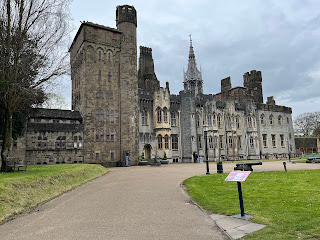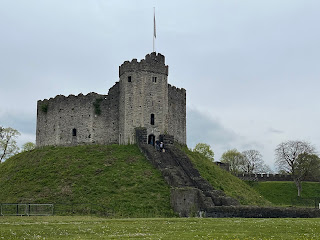See the green under the fish? Mashed peas.
Wales is a country, bordered by England, in the southwest part Great Britain. It is known for its rugged coastline, mountainous national parks, distinctive Welsh language and Celtic culture. It is 8,023 square miles in size (compare to Kansas’ 82,278 square miles. Wales is 130 miles from north to south and varies in width from 40 – 100 miles. Wales has been home to over 600 castles, 100 are still standing today. We stayed in Cardiff which is the capital and largest city of Wales.
A walking tour of Cardiff included the government buildings, churches, and an open market. Wales is also known for limericks – “There was a young woman from Wales….” Our group at dinner even won the limerick writing contest!
Cardiff Castle was once a Roman fort, a Norman castle, and a Victorian Gothic palace. The original castle was built in the 11th century on top of a 3rd century Roman fort. During WWII air raid shelters were built in the castle walls. It was given to the city of Cardiff in 1947 and has been restored and many rooms furnished in antiques and reproductive styles.
The most interesting stop in Wales was St. Fagan’s National Museum of History, an open-air museum chronicling the history culture, and architecture of the Welsh people. Buildings from all over Wales had been taken apart, moved, and reassumed at the museum grounds. They represented a wide range of history showing how people had lived.














No comments:
Post a Comment